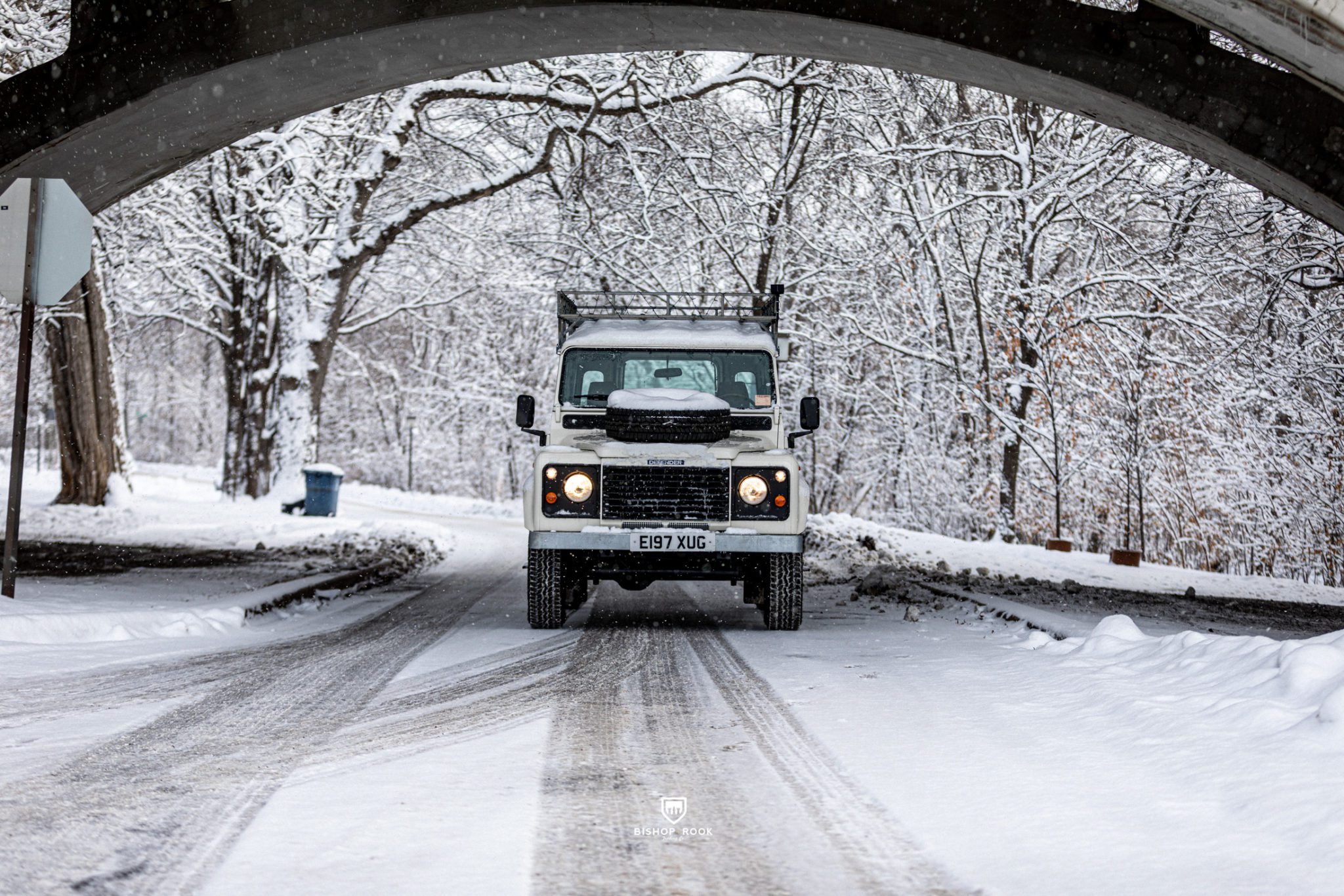There are a lot of variables that go into the final cost of building a Custom Land Rover Defender – from restoration level to final accessories, parts, and finishing trim. One of the things we’ve tried hard to do over the years keeps our Defenders priced at a reasonable and fair level based on the final build quality. We feel like we’re doing a pretty good job so far.
We think we provide the best value for your dollar in the entire Defender building industry – including offering a price-match for any similar build proposal. We are finding it increasingly difficult to provide budget-friendly Defenders, and this post will highlight the reasons why.
In simple terms, we estimate the costs to source, build, and restore a Defender have probably gone up at least 30% in the past year. This will likely continue as inflation surges and demand for unique and reliable vintage Defenders increases.
If you’re waiting to see if the costs to build a Defender are going down, we’re here to explain why that’s not likely to happen. In fact, we are about to increase the costs of our custom Defender builds by an additional 10% starting on any projects we begin in the spring of 2023. We are also eliminating some aspects of our Defender build offering, such as the Preservation Series – as the current climate does not make it viable to provide this level of vehicle at this time. We will offer Preservation Series Defenders that we’ve built ourselves, but not on a custom order basis.
What Drives the Cost to Build a Custom Land Rover Defender
Over the past two years, there have been several factors that have driven the costs to build a Custom Land Rover Defender up. While a good part of the cost increases can be attributed to issues with supply and demand, that’s only part of the equation. Furthermore, we do not see any reverse trend in pricing on Defenders anytime soon. The market is strong and shows no sign of slowing down or retracting. This is probably the cheapest period of time you’ll ever find to purchase or build a Defender – the costs seem to increase on a daily and weekly basis for the services and components that go into building a Defender.
The Cost of Fasteners and the Impact on Building a Defender
We will start with one of the most basic aspects of a Defender build: fasteners. There are thousands of little nuts, bolts, clips, and fasteners that go into building a Defender. Many of the original factory pieces have corroded past their useful life and should be replaced if you’re doing any sort of build or preservation. We keep a pretty detailed spreadsheet and database of all the parts that go into each build. When we recently did a resupply order on fasteners we noticed a nearly 30% increase in the cost of these basic components. This is driven by raw material costs, shipping, and inflation.
Parts Availability + Air Freight Costs
Parts to restore and maintain vintage Land Rover Defenders have always been relatively easy to find. Additionally, prices, compared to other manufacturers, tend to be far more affordable, as well. The issue lately has been with supply chain infrastructure – not only for critical parts – but also the transportation and logistics for moving them from one place in the world to another. This particularly hits large and bulky parts the most – as fewer travelers mean fewer air freight options, which leads to price increases and surcharges.
Our costs to ship parts have tripled in the past 2 years. We sometimes spend just as much on shipping costs as we do on parts. We’ve tried very hard to absorb those costs, but our latest pricing increases are designed to reduce this stress on our build costs. We held out as long as we could, but we don’t see any near-term changes in these cots.
Supply and Demand for Donor Land Rover Defenders
The increasing popularity of the Land Rover Defender in the American market has driven demand for these iconic vehicles around the world. As Bishop+Rook, and countless other Defender builders, scour the globe for import-eligible donors, the market becomes quite crowded. As more and more people show interest in sourcing donor Defenders, the prices naturally increase as owners hold out for better offers on their prized possessions. We have seen the quality of these Defenders go down, while the costs have nearly doubled over the past year. This creates an issue where more work needs to be done to get back to the base level for where a good donor project would have been just 24 months ago. These costs, unfortunately, are passed on to the consumer (or sometimes absorbed by us).
Shipping and Logistics Costs for Land Rover Defenders
With nearly 2 years of transportation shut-downs, vaccine mandates, reduced number of overland truckers, and border restrictions, it became very difficult to even transport a donor project when we found them. We had several Defenders get stuck in Spain for over a year before we could get them shipped out to one of our restoration facilities. It doesn’t take much to add to the bottom line of a Defender build. Increases in fuel costs, for example, caused the price to transport a Defender in the US to go from $.50 a mile to over $1.00 a mile. When we’re transporting a shipment of donors halfway across the country from the Port of Baltimore, that adds up pretty quickly.
 Most of our shipments are transported via RoRo (Roll-on, Roll-Off) boats, we used to ship a few via containers from time to time. The cost of container shipments nearly tripled in the past year – making not only the shipment of vehicles more expensive, but large, bulky, and heavy parts to complete the restoration process. Body panels, chassis, engine packages, wheels, etc. are all fairly unfriendly things to ship. We’ve had instances where we’ve had to pay nearly as much to ship parts as the parts costs themselves.
Most of our shipments are transported via RoRo (Roll-on, Roll-Off) boats, we used to ship a few via containers from time to time. The cost of container shipments nearly tripled in the past year – making not only the shipment of vehicles more expensive, but large, bulky, and heavy parts to complete the restoration process. Body panels, chassis, engine packages, wheels, etc. are all fairly unfriendly things to ship. We’ve had instances where we’ve had to pay nearly as much to ship parts as the parts costs themselves.
Overhead Costs + Facilities Management
While many companies saw huge advantages to remote working teams during the pandemic, there’s no such option for those of us who need to be together in the same workshop to physically get the hard work of restoration completed. We have three different workshops (with a 4th coming online shortly). We keep things pretty simple – as those who have visited us can testify. We don’t have fancy showrooms or teams of photographers following us around all day to document things for social media (we do that with oily hands and mobile phones, typically). If you’re like us, you’ve noticed your heating, electric, and other utility bills spike over the past year. Our heating bill at the Renville workshop nearly tripped from this time last year. In England the guys are used to freezing cold, so we just leave it that way sometimes.
We can only speak for ourselves on how this impacts the overall costs of a restored Defender, but we suspect some of the builders with new 100,000 square foot assembly plants are probably looking for ways to recover those costs. We keep the workshops focused on the task at hand: building exceptional Defenders. While not fancy, we did recently implement a cleaning rule around each workshop called: “What would your mom say if she stopped by right now?” As an owner who typically has to clean the bathrooms myself, I’ve been delighted at the results of this new policy in inspiring the younger guys to clean up after themselves. We still have work to do, but I’ll take any progress we can get.
Labor and Talent Costs
As an employee-owned company, it’s always our top priority to take care of our team members and their families. We have a wonderfully talented and dedicated team that works for Bishop+Rook – both in the United States and England. We have an extremely high retention rate with employees, partially because we get to build Defenders for a living, but also because we support each other. We’ve seen how competitive the marketplace is for today’s companies in terms of attracting and retaining top talent. The automotive restoration industry is not immune to this. While we’re not getting rich building Defenders, we like to make sure we’re also not going bankrupt. Our labor costs and partner costs will likely increase in the next year or more. This will be reflected globally in the cost of Defenders – as we are not unique in this area. All companies building high-quality restored Defenders will continue to see more demand for these exceptionally skilled individuals.
Final Thoughts: Will a Custom Land Rover Defender retain value?
The answer to this question is a resounding yes. A custom-built Land Rover Defender is an excellent investment – whether you’re looking for a reliable daily driver, or simply want a fun second vehicle for the family. A fully-restored vintage Defender can be just as safe and reliable as something that comes off the factory assembly line today. The biggest factor proving the long-term value of a Defender is the timeless style and design of the vehicle. With most modern cars looking and performing nearly identical to each other – with increasing costs – more and more consumers will turn to vintage cars as a way to provide a unique driving experience while fighting the depreciation that these new car counterparts come with on day one.












You must be logged in to post a comment.